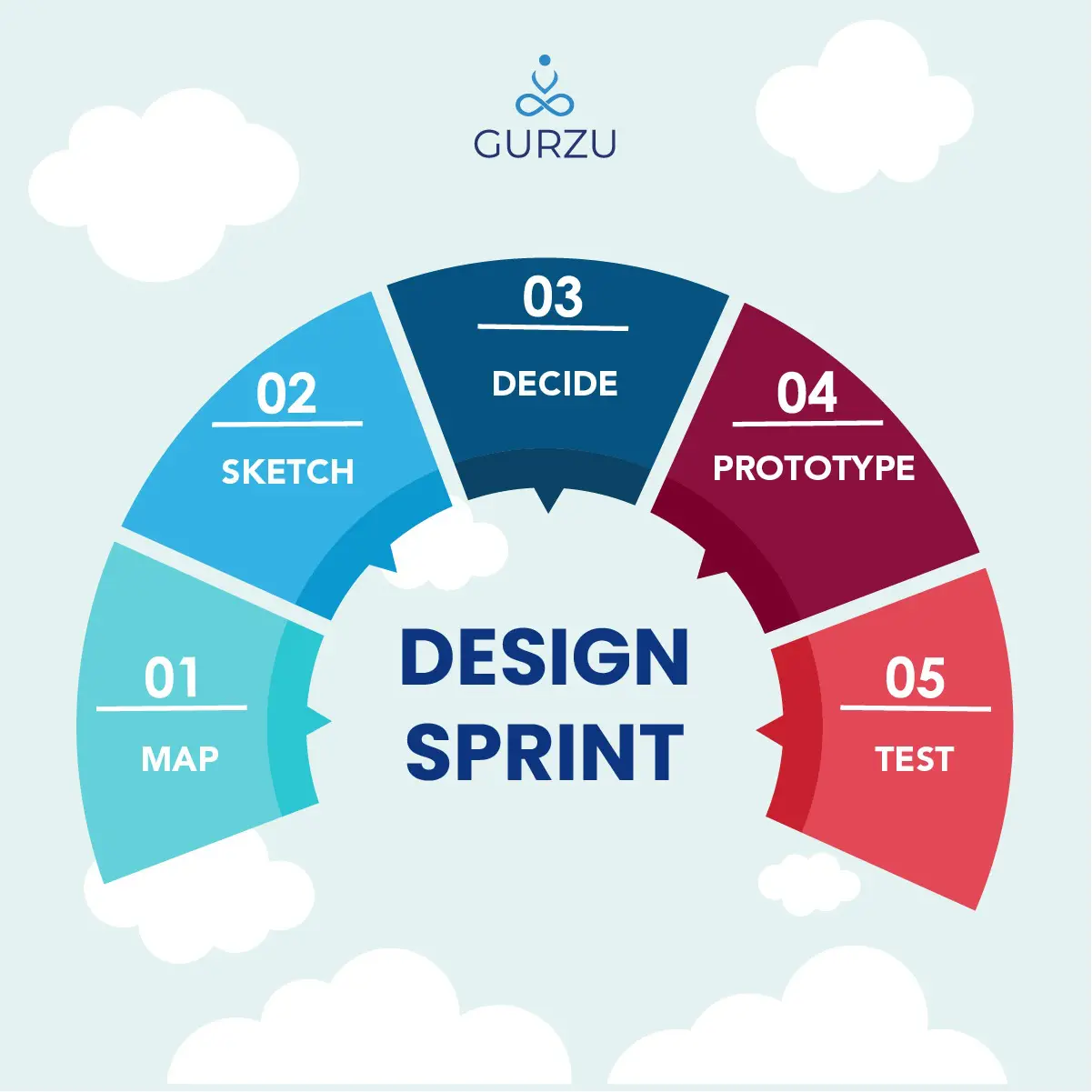Our designers here at Gurzu use a powerful thought tool, a process called Design Sprint which enables us to use design thinking to reduce the risk when bringing a new product, service or a feature to the market for our clients. The Design Sprint is a methodology of agile user experience and product design process that puts the business, technology and especially the user in the center. In simpler words, it’s a process of structured brainstorming for answering critical business questions through design, prototyping, and testing new ideas with users throughout one to five days workshop.
Design Sprint consists of six stages:

Namely,
- Understand
- Define
- Diverge
- Decide
- Prototype
- Validate
We shall go over these six steps of design sprint quickly!
The first phase of the design sprint is the Understanding phase. The first thing after getting the project is to gather further more knowledge about the product, their business model, The end users of the product, their needs and the possible technologies one might use in order to meet the requirements of the market.
After clarifying about the product, appears the Define Stage. In this stage, initial strategy are defined and the best solution is analyzed.
Often times, the first solution we pick that comes to the mind, might not always be the best solution. The Diverge stage is that phase where the actual creativity pops up. Now that we have understood the product and defined a strategy we can add in ideas. Everyone can think using their creativity for solutions to solve the problem. To do so, there’s a great technique called “Crazy 8’s” or “Sketch 8 ideas in 5minutes” : each individual sketches quick 8 potential UI solutions in 5 minutes. The purpose of this activity is to generate many ways of solving the challenge no matter if they’re realistic or not.
After the sketching the team member’s ideas, multiple solutions created in diverge stage are filtered down via voting and the best one or combination of ideas are selected. Hence know as the Decide stage.
The prototype allows us to test our idea. Using prototype, we can predict the success or failure of the product. In Prototype stage, actual testable mockups are created and built. This can be done via paper prototype or the actual physical prototype using InVision.
The prototype made earlier in the phase is then sent to the users. Hence in this stage, we get the answers about how our product will work in the market. We will be getting a lot of feedbacks from our users that actually tested using prototypes.
We at Gurzu, have used design sprint across different projects either with a new product or the existing products while adding features. One of our first was with Kantid. This is how we implemented Design Sprint in Kantid:
- Understand Phase: Our client came to us with just a single line requirement for his product Kantid. We first sat down with the client and clarified our knowledge on the product, the business model and its end customer.
- Define Phase: Then we listed out the possible strategy to achieve the finished product.
- Diverge: Then sketched ideas in 5 minutes that would possibly solve the problem.
- Decide: Amongst the many ideas sketched choosed out the best one via voting by the team members.
- Prototype: Our designer then built mockups: first wireframes and then in InVision. Used invision for interacting with client on wireframes and provided them with demo of the user’s flow.
- Validate: And then submitted them to the client and gathered feedback.
So how Gurzu benefited using Design Sprint?, one might wonder. The Design Sprint just a 5 day work, we could actually develop the idea for the prototype in just a week’s time. Since we did not had clear requirements as our client was also exploring his options. We had to start from scratch and hence building the concept made us easier due to the understanding and the clarity of the product and it’s business model.
Gurzu was able to develop concept for Kantid from scratch using Design Sprint. Planned entire project roadmap for the development, initiated product design, the app architecture and kept on building mocks and wireframes that best suited the product’s business model. Which ultimately made our client happy with the end result. (Read more about success stories)
Similarly, for startups the Design Sprint is a wonderful tool to let them know if their idea will be a success or a failure. Any idea can be predicted in a minimum of a week’s time, which is less time consuming. It will bring all the team members in the same page. By creating quick prototypes, one can get actual feedback and see if there’s a real potential for the solution that they’ve created. One of the major benefit it gives startup is, Design Sprint gives each participant the feeling that his opinion counts which would definitely contribute to a better chemistry and greater synergy in the company.
If anyone is willing to learn more about how we conduct a Design Sprint, you can reach us at Contact Us.
Learn more on Design Sprint, design thinking process from this Youtube video : Designer’s Mindset For A Successful Project.

